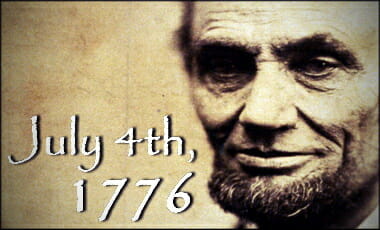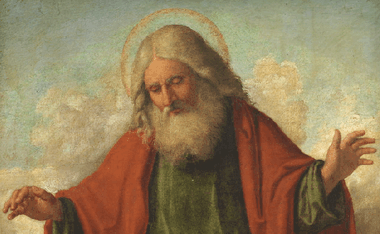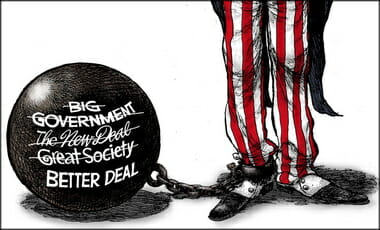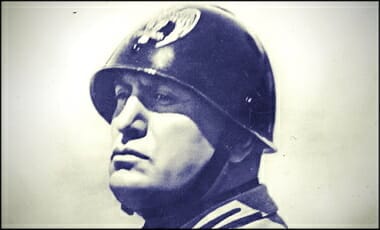What does Planned Parenthood really do? What do they actually stand for? President and founder of Live Action, Lila Rose, lays out everything you need to know about Planned Parenthood.
Prager U


How Lincoln Changed the World in 2-Minutes (Ideals vs. Compromise)
Why do Lincoln’s iconic words at Gettysburg still matter to each and every one of us? Professor Doug Douds of the Army War College explains.

Computer Models Cannot Predict Climate
Predicting climate temperatures isn’t science – it’s science fiction. Emeritus Professor of Physics at Princeton University Will Happer explains.
The following is a snippet from a large post I did for a USPS worker that wanted me to respond to the article from Time Magazine he handed over to me. My LONGER post is entitled:
“Offering Critical Thinking on Global Warming“
Truth be told, they have NO IDEA. Why? Because they rely on computer models, not the actual climate.
Computer Models?
Yes, most of the headlines we read are driven by computer models or cherry-picking from one data set and not taking ACTUAL temperatures into account. For instance:
See more on this @ Dr. Roy Spenser’s site. (BIO):
Roy W. Spencer received his Ph.D. in meteorology at the University of Wisconsin-Madison in 1981. Before becoming a Principal Research Scientist at the University of Alabama in Huntsville in 2001, he was a Senior Scientist for Climate Studies at NASA’s Marshall Space Flight Center, where he and Dr. John Christy received NASA’s Exceptional Scientific Achievement Medal for their global temperature monitoring work with satellites. Dr. Spencer’s work with NASA continues as the U.S. Science Team leader for the Advanced Microwave Scanning Radiometer flying on NASA’s Aqua satellite. He has provided congressional testimony several times on the subject of global warming.
Dr. Spencer’s research has been entirely supported by U.S. government agencies: NASA, NOAA, and DOE. He has never been asked by any oil company to perform any kind of service. Not even Exxon-Mobil.
(CNSNEWS) Global temperatures collected in five official databases confirm that there has been no statistically significant global warming for the past 17 years, according to Dr. John Christy, professor of atmospheric science and director of the Earth System Science Center at the University of Alabama Huntsville (UAH).
Christy’s findings are contrary to predictions made by 73 computer models cited in the United Nation’s latest Intergovernmental Panel on Climate Change (IPCC) Fifth Assessment Report (5AR).
Christy told CNSNews that he analyzed all 73 models used in the 5AR and not one accurately predicted that the Earth’s temperature would remain flat since Oct. 1, 1996. (See Temperatures v Predictions 1976-2013.pdf)
“I compared the models with observations in the key area – the tropics – where the climate models showed a real impact of greenhouse gases,” Christy explained. “I wanted to compare the real world temperatures with the models in a place where the impact would be very clear.” (See Tropical Mid-Troposphere Graph.pdf)
Using datasets of actual temperatures recorded by the NASA Goddard Institute for Space Studies (NASA GISS), the United Kingdom’s Hadley Centre for Climate Prediction and Research at the University of East Anglia (Hadley-CRU), the National Oceanic and Atmospheric Administration (NOAA), satellites measuring atmospheric and deep oceanic temperatures, and a remote sensor system in California, Christy found that “all show a lack of warming over the past 17 years.”
“All 73 models’ predictions were on average three to four times what occurred in the real world,” Christy pointed out. “The closest was a Russian model that predicted a one-degree increase.”

German Meteorologist Says Climate Models Have Gotten 11 Of The Past 12 European Summers Wrong!
German meteorologist Dominik Jung writes at wetter.net that the first preliminary forecast for Central Europe for the upcoming summer issued by the NOAA does not look very favorable. Expect a “grisly summer”, he writes.
He writes that over the last 10 years spring has generally been on the warm and sunny side, but that Central Europeans have had to pay a price for that by having to put up with wet and variable summer weather.
Models wrong 11 out of 12 years!….
… more on this later. One thing you will notice in reading the LA Times article, every pro anthropogenic [man-caused] global warming person named has a professor, or scientist in front of their name or description. Those who disagree with “man-caused” global warming are merely described as skeptics. ALTHOUGH, you at least get this:
Climate scientists, meanwhile, have had a different response. Although most view the pause as a temporary interruption in a long-term warming trend, some disagree and say it has revealed serious flaws in the deliberative processes of the IPCC.
One of the most prominent of these critics is Judith Curry, a climatologist who heads the School of Earth and Atmospheric Sciences at the Georgia Institute of Technology. She was involved in the third IPCC assessment, which was published in 2001. But now she accuses the organization of intellectual arrogance and bias…
In case you are out of the loop, no warming has occurred in 16-years from when this article appeared in the Mail Online:
✦ The figures reveal that from the beginning of 1997 until August 2012 there was no discernible rise in aggregate global temperatures
✦ This means that the ‘pause’ in global warming has now lasted for about the same time as the previous period when temperatures rose, 1980 to 1996
The world stopped getting warmer almost 16 years ago, according to new data released last week.
The figures, which have triggered debate among climate scientists, reveal that from the beginning of 1997 until August 2012, there was no discernible rise in aggregate global temperatures.
This means that the ‘plateau’ or ‘pause’ in global warming has now lasted for about the same time as the previous period when temperatures rose, 1980 to 1996. Before that, temperatures had been stable or declining for about 40 years….
There will always be those who cannot admit the obvious, for obvious reasons (CFACT):
1. The concentration of CO2 in the global atmosphere is lower today, even including human emissions, than it has been during most of the existence of life on Earth.
2. The global climate has been much warmer than it is today during most of the existence of life on Earth. Today we are in an interglacial period of the Pleistocene Ice Age that began 2.5 million years ago and has not ended.
3. There was an Ice Age 450 million years ago when CO2 was about 10 times higher than it is today.
4. Humans evolved in the tropics near the equator. We are a tropical species and can only survive in colder climates due to fire, clothing and shelter.
5. CO2 is the most important food for all life on earth. All green plants use CO2 to produce the sugars that provide energy for their growth and our growth. Without CO2 in the atmosphere carbon-based life could never have evolved.
6. The optimum CO2 level for most plants is about 1600 parts per million, four times higher than the level today. This is why greenhouse growers purposely inject the CO2-rich exhaust from their gas and wood-fired heaters into the greenhouse, resulting in a 40-80 per cent increase in growth.
7. If human emissions of CO2 do end up causing significant warming (which is not certain) it may be possible to grow food crops in northern Canada and Russia, vast areas that are now too cold for agriculture.
8. Whether increased CO2 levels cause significant warming or not, the increased CO2 levels themselves will result in considerable increases in the growth rate of plants, including our food crops and forests.
9. There has been no further global warming for nearly 18 years during which time about 25 per cent of all the CO2 ever emitted by humans has been added to the atmosphere.
I doubt it.
Here is a Patrick Moore quote that shows how the left has politicised the issues we are dealing with above and below:
“I now find that many environmental groups have drifted into self-serving cliques with narrow vision and rigid ideology…. many environmentalists are showing signs of elitism, left-wingism, and downright eco-fascism. The once politically centrist, science-based vision of environmentalism has been largely replaced with extremist rhetoric. Science and logic have been abandoned and the movement is often used to promote other causes such as class struggle and anti-corporatism. The public is left trying to figure out what is reasonable and what is not.”

Prager on Fox & Friends – YouTube/Google Censorship
“Folks on the left are trying to do on the Internet at Google-YouTube… what the left is doing at the universities: Stamping out all non-left ideas.”

The Inconvenient Truth About the Republican Party
When you think of the Republican Party, what comes to mind? If you’re like many Americans, you may associate the GOP with racism, sexism, and general inequality. It’s a commonly pushed narrative by left-leaning media and academia, but as former Vanderbilt Professor of Political Science Carol Swain explains, the Republican Party was actually responsible for nearly every advancement for minorities and women in U.S. history—and remains the champion of equality to this day. (See her other two videos on my “RACIAL MYTHS PAGE.” Dr. Swain is also a main person interviewed in the documentary, INDOCTRINATE U)

Is There Life After This Life?
What happens after we die? Does everything just end? Or, is there something that comes after this life? Who hasn’t asked themselves these questions? In this compelling video, Dennis Prager deals with the issue of the afterlife head on.
 Here is a quote I love from Grant Jeffrey’s book[s] on heaven:
Here is a quote I love from Grant Jeffrey’s book[s] on heaven:
A Hypothetical Test on Your Desire For Heaven
To illustrate this lack of awareness of the reality of Heaven’s glories, I have often during the last few years challenged congregations to participate in an experiment. I ask my audience to imagine for a moment that there is a button on the back of the pew in front of their seat. Then I suggest that they imagine that, if they pushed that button, they and their loved ones would be instantaneously transferred to Heaven to live forever. Then I ask the question, “Would you press the button?” The response of the congregation is fascinating. Usually about one-half of the church audience smile in anticipation of what awaits them in Heaven if their button actually translated them to the presence of Jesus Christ. However, at least half of the audience reveal a perplexed expression on their faces that showing that they have little interest in pushing that hypothetical button. Ask yourself this question: Would I want to go to Heaven today with all my loved ones? If the answer is NO; why not?
Your Mental Image of Heaven
I have asked congregation members in private conversations their real reasons why they would either “push the button” or not. Their responses were quite revealing. Your personal mental image of Heaven will determine to a great degree your attitude and longing for the eternal city. Those Christians who would press this hypothetical button are usually mature believers who are strong in their faith due to many hours spent studying the promises of God. As a result of personal Bible study, reading a book, or attending a church where the pastor taught these great truths, the Christians who would choose to press the button have obtained a strong conviction of the reality of God’s promise. They are not suicidal; nor do they lack plans for their future. They simply believe that Heaven is as real as this Earth and they are prepared to joyfully go home whenever Jesus Christ calls them. On the other hand, those Christians who would not choose to push the button almost invariably had received little teaching about the reality of Paradise. When I asked these believers to describe the mental image that went through their mind when they thought about Heaven their answers were very revealing about why they wanted to avoid this as long as possible. They didn’t want to avoid Heaven forever; they just had no desire to go there now because of their mental image of it. They would prefer to wait until they were ninety-seven years old with one foot in the grave before they pushed that button and went to the heavenly city.
What was the mental image of Heaven held by those who didn’t want to go there now? Many of them told me that they thought they would spend eternity sitting on a cloud playing a harp in an endless eternal church service that would never, ever, ever end. In other words, if they were honest, they thought of Heaven as being an incredibly boring place with nothing worth doing, nowhere to go and an eternity of passivity with no activity. Naturally their vision of the New Jerusalem was about as exciting as watching the grass grow on your back lawn. It is no wonder that such Christians have little interest or motivation regarding God’s promises about our eternal home. Does their description resemble your own present view of Heaven? If it does, then you are in for a delightful journey of discovery as we examine the true reality of what the Bible teaches us about the glories of Heaven.
CONSEQUENCES OF BELIEF IN HEAVEN/HELL
From Video Description:
In this “Ultimate Issues Hour,” Dennis Prager (a conservative Jew) discusses “Ultimate Justice” (God’s Justice and otherwise) and justice’s involvement/affect in/on behavior. A new study reveals that belief in hell [and heaven] predicted a lower crime rate; belief in heaven predicted more crimes. Dennis tackles this hard to explain — or is it — issue. This is uploaded because of an article by a detective and Christian apologist that likewise deals head-on with these questions as well (Cold Case). Detective Wallace says, “Criminals who justify their actions with religious doctrines are typically woefully ignorant of (or purposefully distorting) these doctrines,” I concur. Having been in jail for almost a full year-and-a-half with three felonies, I know first hand the psychological crutch religion can play, rather than the Refiner’s Fire Christianity is meant to be (Zechariah 13:9, 1 Peter 1:7, Job 23:10, Isaiah 48:10). I will add that “Liberalism,” wherever it is applied (politics, economics, faith, ethics, and the like), harms immeasurably the actions of those involved in it. Theology is no less hurt by this progressive matrix. Just the latest example of this are those that are opposed to pro-lifers support of a bill that will stop late-term abortions. They can be heard chanting “hail Satan” in response to others singing “Amazing Grace.” As well as “fu*k the church!” The Democrats that once supported and made up John F. Kennedy’s base would not recognize the liberal Democratic party of today. Which is why Dennis says (as well as Reagan) that the Democratic Party left them, not the other way around.
- A University of Oregon psychologist has found that a country’s belief in heaven and hell is related to its crime rates, and that a belief in a punitive God equals less crime while a belief in a forgiving savior means more crime. (CHRISTIAN POST)
And of course…
The LEWIS!
Finally, it is objected that the ultimate loss of a single soul means the defeat of omnipotence. And so it does. In creating beings with free will, omnipotence from the outset submits to the possibility of such defeat. What you call defeat, I call miracle: for to make things which are not Itself, and thus to become, in a sense, capable of being resisted by its own handiwork, is the most astonishing and unimaginable of all the feats we attribute to the Deity. I willingly believe that the damned are, in one sense, successful, rebels to the end; that the doors of hell are locked on the inside. I do not mean that the ghosts may not wish to come out of hell, in the vague fashion wherein an envious man “wishes” to be happy: but they certainly do not will even the first preliminary stages of that self-abandonment through which alone the soul can reach any good. They enjoy forever the horrible freedom they have demanded, and are therefore self-enslaved just as the blessed, forever submitting to obedience, become through all eternity more and more free.
C.S. Lewis, The Problem of Pain (New York, NY: Simon & Shuster, 1996), 113-114.
This is an illustration of C.S Lewis’ third talk of the third radio series called ‘What Christians Believe’. This became Chapter 3 of Book 2, in the book called ‘Mere Christianity’.

Participation Trophies
Should kids be given trophies for playing sports, even when they don’t win? Are participation trophies a good or bad thing for young athletes? Former Olympian and LA Galaxy soccer star Cobi Jones shares his thoughts.
Here is some commentary (my own) from another post on my site:
….Today, however, with a generation growing up with getting PARTICIPATION TROPHIES for anything they were involved in, passing out birthday cards to everyone in a classroom so people’s feelings are not hurt, or not playing sports that would have competition as its goal (winners or losers) or exclude a gender… elite is the entire swath of progressive liberals.
Some may not even know how to classify themselves as fitting into this camp. They may not have even the tools presented to them through high-school and college to self reflect on their worldview. It doesn’t matter, even if they do not know they have a worldview guiding their lives, they have allowed progressivism to do it for them, blinded by good intentions, not knowing every tyranny was for “good intentions.”
- “All propaganda has to be popular and has to accommodate itself to the comprehension of the least intelligent of those whom it seeks to reach.” ~ Mein Kampf (1935)
Who are the liberal elite? Half our nation. Elitist in the idea of their hubris and ego (controlling gender and weather through legislation, and changing God’s or Natures edict of the ideal environment to raise children). All have given themselves a pat on their back and a PARTICIPATION TROPHY. Elitist in that they have rejected 5-to-6 thousand years of man (written history) applying things to see if they work or do not work. Elite in their vacuous “atta boys.” Elite in the fact that they have swallowed empty accolades and propaganda dressed up as “equality.”
LEGENDS in their own minds.
The men who wrote our Founding Documents were students of history and philosophy, religious and political.
The Elites of today are students of their own good-pleasure or in a constant flux of emotive states… doing only what makes them tickled pink inside.

How To Turbocharge The American Economy
“Small businesses are the engine of the American economy.”
Roughly half of the United States’ workforce depends on small businesses thriving. But high taxes and intrusive government regulations hurt these businesses and their workers. How would tax cuts for these small businesses benefit the U.S. economy and help just about everyone?

Where Does All The Governments Money Come From?
Did you know that the U.S. federal government collects more than $3 trillion in taxes each year? Where does all that money come from?

Net Neutrality – Ma Bell
Here is a comment via my LIVELEAK [now defunct] (rough language warning):
Pai is right. The neutrality storm is being shilled up by the content providers that are scared they will have to actually start paying market rates for their access. The loudest is Netflix, and anybody with at least two brain cells (and a functioning ability to give a shit) know that’s the bunch that melted down a lot of peering among the major networks while screaming for those same networks to increase Netflix’s transit capacity for free. They stir the ignorant masses up with bullshit about ‘equal access’ while their data accounts for up to 70% of the total internet bandwidth demand and 90/10 asymmetrical peering transits. They talked the weak Obama administration into legislation to favor their business, calling it “Net Neutrality” and are now pissed they are about to lose that favoritism.
The stupid sheep are screaming that ISPs will fuck them over with fees and blocked content while the fat cat content providers sit back and grin at how easy it is to manipulate their minions. The internet was created and ran just fine for twenty years before the unnecessary Obama “Net Neutrality” doctrine. The doomsday claims of the NN bunch are belied by the facts.
Wanted to get this portion of an important article here — via THE MISES INSTITUTE:
The Natural-Monopoly Myth: Telephone Services
The biggest myth of all in this regard is the notion that telephone service is a natural monopoly. Economists have taught generations of students that telephone service is a “classic” example of market failure and that government regulation in the “public interest” was necessary. But as Adam D. Thierer recently proved, there is nothing at all “natural” about the telephone monopoly enjoyed by AT&T for so many decades; it was purely a creation of government intervention.”54
Once AT&T’s initial patents expired in 1893, dozens of competitors sprung up. “By the end of 1894 over 80 new independent competitors had already grabbed 5 percent of total market share … after the turn of the century, over 3,000 competitors existed.55 In some states there were over 200 telephone companies operating simultaneously. By 1907, AT&T’s competitors had captured 51 percent of the telephone market and prices were being driven sharply down by the competition. Moreover, there was no evidence of economies of scale, and entry barriers were obviously almost nonexistent, contrary to the standard account of the theory of natural monopoly as applied to the telephone industry.56
The eventual creation of the telephone monopoly was the result of a conspiracy between AT&T and politicians who wanted to offer “universal telephone service” as a pork-barrel entitlement to their constituents. Politicians began denouncing competition as “duplicative,” “destructive,” and “wasteful,” and various economists were paid to attend congressional hearings in which they somberly declared telephony a natural monopoly. “There is nothing to be gained by competition in the local telephone business,” one congressional hearing concluded.57
The crusade to create a monopolistic telephone industry by government fiat finally succeeded when the federal government used World War I as an excuse to nationalize the industry in 1918. AT&T still operated its phone system, but it was controlled by a government commission headed by the postmaster general. Like so many other instances of government regulation, AT&T quickly “captured” the regulators and used the regulatory apparatus to eliminate its competitors. “By 1925 not only had virtually every state established strict rate regulation guidelines, but local telephone competition was either discouraged or explicitly prohibited within many of those jurisdictions.”58
Conclusions
The theory of natural monopoly is an economic fiction. No such thing as a “natural” monopoly has ever existed. The history of the so-called public utility concept is that the late 19th and early 20th century “utilities” competed vigorously and, like all other industries, they did not like competition. They first secured government-sanctioned monopolies, and then, with the help of a few influential economists, constructed an expost rationalization for their monopoly power.
This has to be one of the greatest corporate public relations coups of all time. “By a soothing process of rationalization,” wrote Horace M. Gray more than 50 years ago, “men are able to oppose monopolies in general but to approve certain types of monopolies. … Since these monopolies were ‘natural’ and since nature is beneficent, it followed that they were ‘good’ monopolies. … Government was therefore justified in establishing ‘good’ monopolies.”59
In industry after industry, the natural monopoly concept is finally eroding. Electric power, cable TV, telephone services, and the mail, are all on the verge of being deregulated, either legislatively or de facto, due to technological change. Introduced in the United States at about the same time communism was introduced to the former Soviet Union, franchise monopolies are about to become just as defunct. Like all monopolists, they will use every last resource to lobby to maintain their monopolistic privileges, but the potential gains to consumers of free markets are too great to justify them. The theory of natural monopoly is a 19th century economic fiction that defends 19th century (or 18th century, in the case of the US Postal Service) monopolistic privileges, and has no useful place in the 21st century American economy.
- This article was originally published in The Review of Austrian Economics 9 (2), 1996.
Let me caveat this next excerpt by saying I am NOT a fan of the New American Magazine. They are a John Birch publication, and my understanding of this organization is intimate, and so are my ultimate rejection of many of it’s positions. THAT BEING SAID, I thoroughly enjoyed this article (minus the NWO crap!) — THE BREAKUP OF MA BELL:
….Alexander Graham Bell patented the telephone on March 7, 1876, but initially it was considered no more than a passing novelty. In fact, Western Union passed up the opportunity to purchase the Bell patents for $100,000. But when those patents held by American Telephone and Telegraph Company expired in 1894, competition entered the market and the availability of telephone service and the number of telephones exploded. The telephone moved from novelty to necessity. According to Adam Thierer of the Cato Institute, there were, at the time, more than 3,000 telephone companies vying for customers. Author G. W. Brock, in his book The Telecommunications Industry, pointed out the difference competition made:
After seventeen years of monopoly [thanks to the patents held by AT&T from 1877 – 1894], the United States had a limited telephone system of 270,000 phones [mostly concentrated] in the centers of the cities, with service generally unavailable in the outlying areas. After thirteen years of competition [1907], the United States had an extensive system of six million telephones, almost evenly divided between Bell and [its competitors], with service available practically anywhere in the country. [Emphasis added.]
Writing in The New Telecommunications Industry, authors Leonard Hyman, Richard Toole, and Rosemary Avellis concluded that “competition helped to expand the market, bring down costs, and lower prices to consumers.” Because of the negative impact upon AT&T by its competitors, the president of AT&T, Theodore Newton Vail, changed the focus of the company from competition to consolidation. As noted by Thierer, “Vail’s most important goals upon taking over AT&T were the elimination of competitors, the befriending of policymakers and regulators, and the expansion of telephone service to the general public.” Vail’s belief in the superiority of a single monopolistic system was reflected in the company’s new corporate slogan, “One Policy, One System, Universal Service.” In the company’s 1910 annual report, Vail wrote:
- It is believed that the telephone system should be universal, interdependent and intercommunicating, affording opportunity for any subscriber of any exchange to communicate with any other subscriber of any other exchange…. It is believed that some sort of a connection with the telephone system should be within reach of all….
- It is not believed that this can be accomplished by separately controlled or distinct systems nor that there can be competition in the accepted sense of competition…. [Emphasis added.]
- It is believed that all this can be accomplished to the reasonable satisfaction of the public with its acquiescence, under such control and regulation as will afford the public much better service at less cost than any competition or government-owned monopoly could permanently afford…. [Emphasis added.]
- Effective, aggressive competition and regulation and control are inconsistent with each other, and cannot be had at the same time.
Author R.H.K. Vietor, writing in Contrived Competition, said, “Vail chose at this time to put AT&T squarely behind government regulation, as the quid pro quo for avoiding competition. This was the only politically acceptable way for AT&T to monopolize telephony.” In fact, without government regulations eliminating the competition, the reinstitution of the AT&T monopoly would have been impossible. The Kingsbury Commitment (named for one of Vail’s employees) was an agreement with the Attorney General and the Interstate Commerce Commission in 1913 that essentially codified the playing field which allowed AT&T to regain monopoly control of the industry.
In 1934, the power to regulate the telephone industry under the ICC was transferred to the new Federal Communications Commission. Enacted by the Roosevelt Revolution during the Great Depression, the Communications Act of 1934 created the FCC “for the purpose of regulating interstate and foreign commerce in communication by wire and radio so as to make available, so far as possible, to all the people of the United States a rapid, efficient, nation-wide, and world-wide wire and radio communication service with adequate facilities at reasonable charges.” In other words, according to Thierer, “every American was henceforth found to be entitled to the right to telephone service, specifically cheap telephone service.” The FCC’s powers included the power to regulate rates and restrict entry by competitors, all in the name of preventing “wasteful duplication” and “unneeded competition.”…..
For months, it seemed nearly every media figure was in hysterics over the impending repeal of net neutrality. Then, net neutrality was repealed… and nothing much changed. So what exactly is net neutrality, and why do so many people have such strong opinions about something they don’t understand? Jon Gabriel, editor-in-chief of Ricochet.com cuts through the hysteria to bring you the facts.
MORE
- John Fund: The Net Neutrality Coup (Orange County Register – 2010)
- Opinion: The FCCs Net Neutrality Victory Is Anything But (Wired – 2015)
- 7 Reasons Net Neutrality Is Idiotic (The Daily Wire – 2017)
- Don’t Blame Big Cable. It’s Local Governments That Choke Broadband Competition (Wired – 2013)
- Ma Bell Suppressed Innovation for Thirty Grueling Years (F.E.E. – 2016)
- The Free Market Doesn’t Need Government Regulation (Reason – 2012)
- Lessons From The At&T Break Up, 30 Years Later (AEI – 2014)
- Limbaugh is Right, Net Neutrality Is An Attack On Free Speech — So Why Is Comcast For It? (Forbes – 2014)
- Internet Access Should Be Left to the Free Market (F.E.E. – 2000)
- What Killed Ma Bell? (F.E.E. – 1984)
- Millennial Asks for Net Neutrality Explanation (Rush – 2017)
- Net Neutrality Flashback (RPT – 2017)

An Arab Muslim in the Israeli Army Speaks FOR Israel
Why would an Arab Muslim serve in the Israeli military? Because he, like many Israeli Arabs, proudly defend the nation that has given them freedom and opportunity. Mohammad Kabiya, Israeli Air Force reservist, shares his remarkable story.

Is Fascism Right Or Left?
Here is an extended quote from Dinesh D’Souza’s book, THE BIG LIE, detailing the easy switch from socialist leaders and unions to fascist — overnight:
…on March 23, 1919, one of the most famous socialists in Italy founded a new party, the Fasci di Combattimento, a term that means “fascist combat squad.” This was the first official fascist party and thus its founding represents the true birth of fascism. By the same token, this man was the first fascist. The term “fascism” can be traced back to 1914, when he founded the Fasci Rivoluzionari d’Azione Internazionalista, a political movement whose members called themselves fascisti or fascists.
In 1914, this founding father of fascism was, together with Vladimir Lenin of Russia, Rosa Luxemburg of Germany, and Antonio Gramsci of Italy, one of the best known Marxists in the world. His fellow Marxists and socialists recognized him as a great leader of socialism. His decision to become a fascist was controversial, yet he received congratulations from Lenin who continued to regard him as a faithful revolutionary socialist. And this is how he saw himself.
That same year, because of his support for Italian involvement in World War I, he would be expelled from the Italian Socialist Party for “heresy,” but this does not mean he ceased to be a socialist. It was common practice for socialist parties to expel dissenting fellow socialists for breaking on some fine point with the party line. This party reject insisted that he had been kicked out for making “a revision of socialism from the revolutionary point of view.” For the rest of his life—right until his lifeless body was displayed in a town square in Milan—he upheld the central tenets of socialism which he saw as best reflected in fascism.
Who, then, was this man? He was the future leader of fascist Italy, the one whom Italians called Il Duce, Benito Mussolini.
Mussolini’s socialist credentials were impeccable. He had been raised in a socialist family and made a public declaration in 1901, at the age of eighteen, of his convictions. By twenty-one, he was an orthodox Marxist familiar not only with the writings of Marx and Engels but also of many of the most influential German, Italian, and French Marxists of the fin de siecle period. Like other orthodox Marxists, Mussolini rejected religious faith and authored anti-Catholic pamphlets repudiating his native Catholicism.
Mussolini embarked on an active career as a writer, editor, and political organizer. Exiled to Switzerland between 1902 and 1904, he collaborated with the Italian Socialist Party weekly issued there and also wrote for Il Proletario, a socialist weekly published in New York. In 1909 Mussolini made another foreign sojourn to Trento—then part of Austria-Hungary—where he worked for the socialist party and edited its newspaper. Returning the next year to his hometown of Forli, he edited the weekly socialist publication La Lotta di Classe (The Class War). He wrote so widely on Marxism, socialist theory, and contemporary politics that his output now fills seven volumes.
Mussolini wasn’t just an intellectual; he organized workers’ strikes on behalf of the socialist movement both inside and outside of Italy and was twice jailed for his activism. In 1912, Mussolini was recognized as a socialist leader at the Socialist Congress at Reggio Emilia and was appointed to the Italian Socialist Party’s board of directors. That same year, at the age of twenty-nine, he became editor of Avanti!, the official publication of the party.
From the point of view of the progressive narrative—a narrative I began to challenge in the previous chapter—Mussolini’s shift from Marxian socialism to fascism must come as a huge surprise. In the progressive paradigm, Marxian socialism is the left end of the spectrum and fascism is the right end of the spectrum. Progressive incredulity becomes even greater when we see that Mussolini wasn’t just any socialist; he was the recognized head of the socialist movement in Italy. Moreover, he didn’t just climb aboard the fascist bandwagon; he created it.
Today we think of fascism’s most famous representative as Adolf Hitler. Yet as I mentioned earlier, Hitler didn’t consider himself a fascist. Rather, he saw himself as a National Socialist. The two ideologies are related in that they are both based on collectivism and centralized state power. They emerge, one might say, from a common point of origin. Yet they are also distinct; fascism, for instance, had no intrinsic connection with anti-Semitism in the way that National Socialism did.
In any event, Hitler was an obscure local organizer in Germany when Mussolini came to power and, following his famous March on Rome, established the world’s first fascist regime in Italy in 1922. Hitler greatly admired Mussolini and aspired to become like him. Mussolini, Hitler said, was “the leading statesman in the world, to whom none may even remotely compare himself.” Hitler modeled his failed Munich Putsch in November 1923 on Mussolini’s successful March on Rome.
When Hitler first came to power he kept a bust of Mussolini in his office and one German observer termed him “Germany’s Mussolini.” Yet later, when the two men first met, Mussolini was not very impressed by Hitler. Mussolini became more respectful after 1939 when Hitler conquered Austria, Poland, Czechoslovakia, Belgium, Norway, and France. Hitler continued to uphold Mussolini as “that unparalleled statesman” and “one of the Caesars” and confessed that without Italian fascism there would not have been a German National Socialism: “The brown shirt would probably not have existed without the black shirt.”
Hitler was, like Mussolini, a man of the Left. Hitler too was a socialist and a labor leader who founded the German Socialist Workers’ Party with a platform very similar to that of Mussolini’s fascist party. Yet Hitler came to power in the 1930s while Mussolini ruled through most of the 1920s. Mussolini was, during those years, much more famous than Hitler. He was recognized as the founding father of fascism. So any account of the origin of fascism must focus not on Hitler but on Mussolini. Mussolini is the original and prototypical fascist.
From Socialism to Fascism
So how—to return to the progressive paradigm—do progressives account for Mussolini’s conversion from socialism to fascism, or more precisely for Mussolini’s simultaneous embrace of both? The problem is further deepened by the fact that Mussolini was not alone. Hundreds of leading socialists, initially in Italy but subsequently in Germany, France, and other countries, also became fascists. In fact, I will go further to say that all the leading figures in the founding of fascism were men of the Left. “The first fascists,” Anthony James Gregor tells us, “were almost all Marxists.”
I will cite a few examples. Jean Allemane, famous for his role in the Dreyfus case, one of the great figures of French socialism, became a fascist later in life. So did the socialist Georges Valois. Marcel Deat, the founder of the Parti Socialiste de France, eventually quit and started a pro-fascist party in 1936. Later, he became a Nazi collaborator during the Vichy regimeVacques Doriot a French communist, moved his Parti Populaire Francais into the fascist camp.
The Belgian socialist theoretician Henri de Man transitioned to becoming a fascist theoretician. In England. Oswald Mosley, a socialist and Labor Party Member of Parliament, eventually broke with the Labor Party because he found it insufficiently radical. He later founded the British Union of Fascists and became the country’s leading Nazi sympathizer. In Germany, the socialist playwright Gerhart Hauptmann embraced Hitler and produced plays during the Third Reich. After the war, he became a communist and staged his productions in Soviet-dominated East Berlin
In Italy, philosopher Giovanni Gentile moved from Marxism to fascism, as did a host of Italian labor organizers: Ottavio Dinale, Tullio Masotti, Carlo Silvestri, and Umberto Pasella. The socialist writer Agostino Lanzillo joined Mussolini’s parliament as a member of the fascist party Nicola Bombacci, one of the founders of the Italian Communist Party, became Mussolini’s top adviser in Salo. Gentile’s disciple Ugo Spirito, who also served Mussolini at Salo, moved from Marxism to fascism and then back to Marxism. Like Hauptmann, Spirito became a communist sympathizer after World War II and called for a new “synthesis” between communism and fascism.
Others who made the same journey from socialism to fascism will be named in this chapter, and one thing that will become very clear is that these are not “conversion” stories. These men didn’t “switch” from socialism to fascism. Rather, they became fascists in the same way that Russian socialists became Leninist Bolsheviks. Like their Russian counterparts, these socialists believed themselves to be growing into fascism, maturing into fascism, because they saw fascism as the most well thought out, practical form of socialism for the new century.
Progressivism simply cannot account for the easy traffic from socialism to fascism. Consequently, progressives typically maintain complete silence about this whole historical relationship which is deeply embarrassing to them. In all the articles comparing Trump to Mussolini I searched in vain for references to Mussolini’s erstwhile Marxism and lifelong attachment to socialism. Either from ignorance or from design, these references are missing.
Progressive biographical accounts that cannot avoid Mussolini’s socialist past nevertheless turn around and accuse Mussolini—as the Socialist Party of Italy did in 1914—of “selling out” to fascism for money and power. Other accounts contend that whatever Mussolini’s original convictions, the very fact that his fascists later battled the Marxists and traditional socialists clearly shows that Mussolini did not remain a socialist or a man of the Left.
But these explanations make no sense. When Mussolini “sold out” he became an outcast. He had neither money nor power. Nor did any of the first fascists embrace fascism for this reason. Rather, they became fascists because they saw fascism as the only way to rescue socialism and make it viable. In other words, their defection was within socialism—they sought to create a new type of socialism that would actually draw a mass following and produce the workers’ revolution that Marx anticipated and hoped for.
Vicious fights among socialist and leftist factions are a recognized feature of the history of socialism. In Russia, for example, there were bloody confrontations between the rival Bolsheviks and Mensheviks. Later the Bolsheviks split into Leninists and Trotskyites, and Trotsky ended up dead on Lenin’s orders. These were all men of the Left. What these bloody rivalries prove is that the worst splits and conflicts sometimes arise among people who are ideologically very similar and differ on relatively small—though not small to them—points of doctrine.
In this chapter I will trace the development of fascism by showing precisely how it grew out of a doctrinal division within the community of Marxian socialists. In short, I will prove that fascism is exclusively a product of the Left. This is not a case of leftists who moved right. On the contrary, the fascists were on the left end of the socialist movement. They saw themselves not as jettisoning Marxism but as saving it from obsolescence. From their perspective, Marxism and socialism were too inert and needed to be adjusted leftward. In other words, they viewed fascism as more revolutionary than traditional socialism.
[….]
Mussolini didn’t believe in race and he wasn’t initially a nationalist; rather, he was a revolutionary syndicalist. The term syndicalism refers to the associations or syndicates to which workers belonged. These were autonomous workers organizations that resembled unions, but they were not unions because the syndicates were organized regionally rather than by corporation or occupation. As dedicated Marxists, the revolutionary syndicalists agreed with Marx that class associations were primary, and that they must be the organizing principle of socialist revolution.
Very much in keeping with this class emphasis that was so central to Marx, the syndicalists, strongly influenced by Sorel, sought to rally the labor syndicates through a general strike that would overthrow the ruling class and establish socialism in Italy. This is what made them “revolutionary.” They intended to foment revolution, not wait for it to happen. They were considered the smartest, most dedicated people in the Italian Socialist Party and they occupied the left wing of the party.
The big names in revolutionary syndicalism were Giuseppe Prezzolini, Angelo 0. Olivetti, Arturo Labriola, Filippo Corridoni, Paolo Orano, Michele Bianchi, and Sergio Panunzio. Most of them were writers or labor organizers. All of them were socialists, and shortly all of them would be camelascists, even though Labriola opposed Mussolini’s regime when it came to power and Corridoni, who was killed in World War I, didn’t live to see it.
Mussolini was their acknowledged leader. He knew them well and conspired with them at meetings and rallies. He read their books and articles and published in their magazines like the Avanguardia Socialista, founded by Laboriola, which was the leading journal of syndicalist thought. Mussolini also reviewed and published the leading syndicalists in his own socialist publications.
Like all revolutionary socialists, the syndicalists had little faith in democratic parliamentary procedures and, consistent with Sorel and Lenin, they sought a charismatic leader who would inspire the workers to action. Mussolini, more than anyone else, fit their prescription. Mussolini was the one who led the syndicalists into a union with the nationalists in order to form the new socialist hybrid called fascism in Italy and (with some modifications) National Socialism in Germany.
The syndicalists organized three general strikes in Italy in 1904, 1911, and 1913. Mussolini supported the strikes. The 1904 strike began in Milan and spread across the country. Five million workers walked off their jobs. The nation was paralyzed: there was no public transportation, and no one could buy anything. Even so, the strike ended without causing either the fall of the government or the installation of socialism.
- Dinesh D’Souza, The Big Lie: Exposing the NAZI Roots of the American Left (Washington, DC: Regnery Publishing, 2017), 65-70, 82-83.

